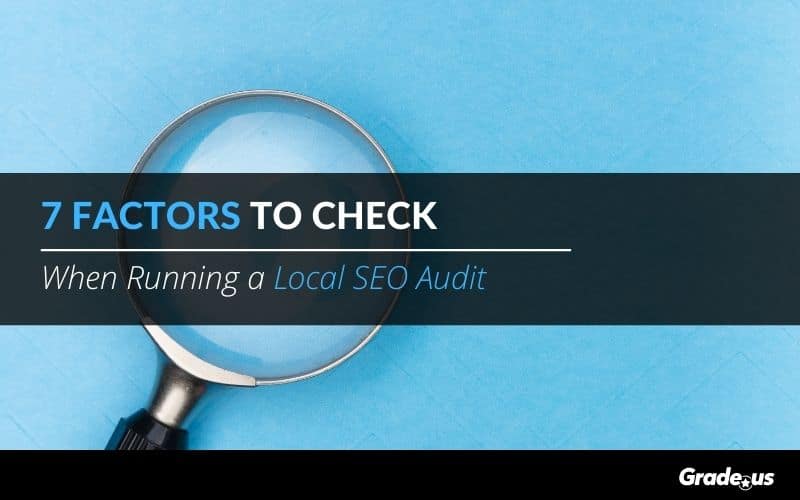Local SEO is the process of enhancing the visibility of businesses in local online searches. Think of local SEO as organic SEO with a local geographic quotient. Below are four statistics gathered from Hubspot that highlight the importance of local SEO:
- 46% of all Google searches are for local businesses
- 89% of users search for a local business at least once a week
- 58% of users search for a local business daily
- 76% of local searches result in a store visit within 24 hours
If you can get your business in front of these customers, there are good chances that they will soon walk through your doors. If you’re trying to target local customers when was the last time you did a local SEO audit?
What is local SEO, what are its benefits, and who is it for?
What is Local SEO? It’s a set of strategies implemented to improve the visibility of your business in search engine results.
Let’s say your business is a pizzeria located on the Upper West Side in New York City. Implementing local SEO strategies will give your business visibility in Google Maps and search engine results pages (SERPs) when a user in the Upper West Side searches for ” pizza near me” or “pizza in New York”.
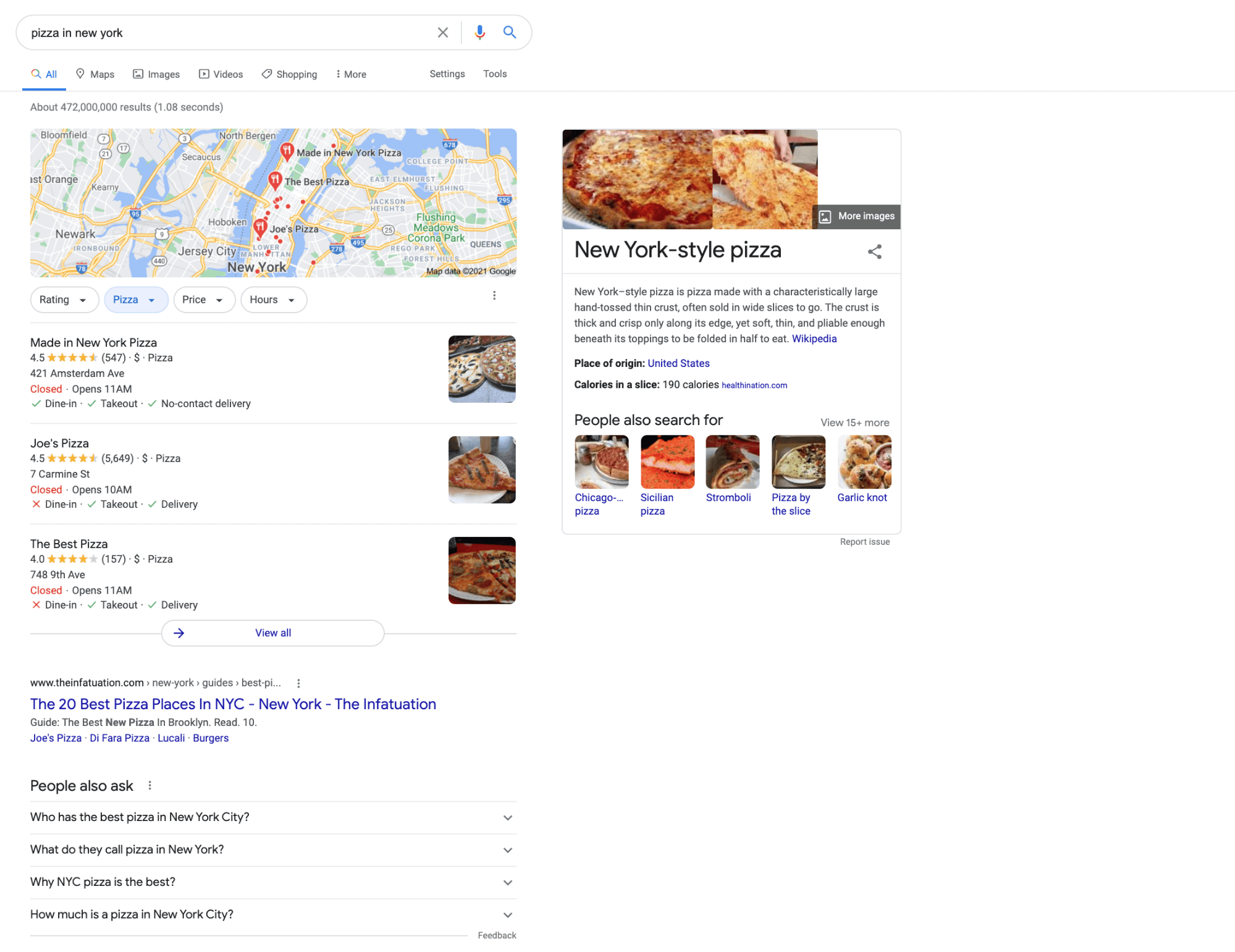
Whether you’re running a pizzeria in NYC or a furniture store in Houston, Texas, local SEO will help to drive customers to your door.
Today, online platforms like Amazon and retail giants like Walmart dominate the retail landscape, leaving many business owners wondering if they should invest time and money in SEO activities. After all, you’re never going to outrank the giants.
But you absolutely should invest in local SEO. Here’s why. People using local search terms are looking for a local business just like yours, and search engines respond to that customer intent. As a small business, if you implement local SEO and a review management system such as Grade.us, there are good chances that your business will rank ahead of the giants in local searches.
Local SEO is relevant for all businesses that serve a specific geographic area. This includes local establishments like restaurants, bars, grocery stores, and laundromats. It also includes service-based businesses such as electricians, plumbers, lawyers, real estate agents, and similar professionals who serve a specific region. All these businesses need to implement local SEO audits in order to drive customers to their doors.
How to run a local SEO audit
Let’s start by understanding why you’re running the local SEO audit and its key components.
An audit allows you to evaluate your current local SEO performance, showing you where you need to plug the gaps in your local search strategy to boost your ranking. Local SEO can also help you to drive traffic, make more sales, and encourage more customers to visit your business. In short, a local SEO audit is a health check of your SEO implementation. It’s a good idea to perform one periodically.
Don’t forget to implement a robust analytics system using Google Analytics and Search Console to measure your performance. You can also use an SEO API to improve and track your performance.
Search engine algorithms look at over 50 factors while deciding rankings for local searches. In their 2020 Local Ranking Search Factors Survey, Whitespark has identified the following seven critical factors that experts believe account for over 94% of the weightage in these algorithms:
- Google My Business (33%)
- Review signals (16%)
- On-page signals (15%)
- Link signals (15%)
- Behavioral signals (8%)
- Citation signals (7%)
- Personalization (6%)
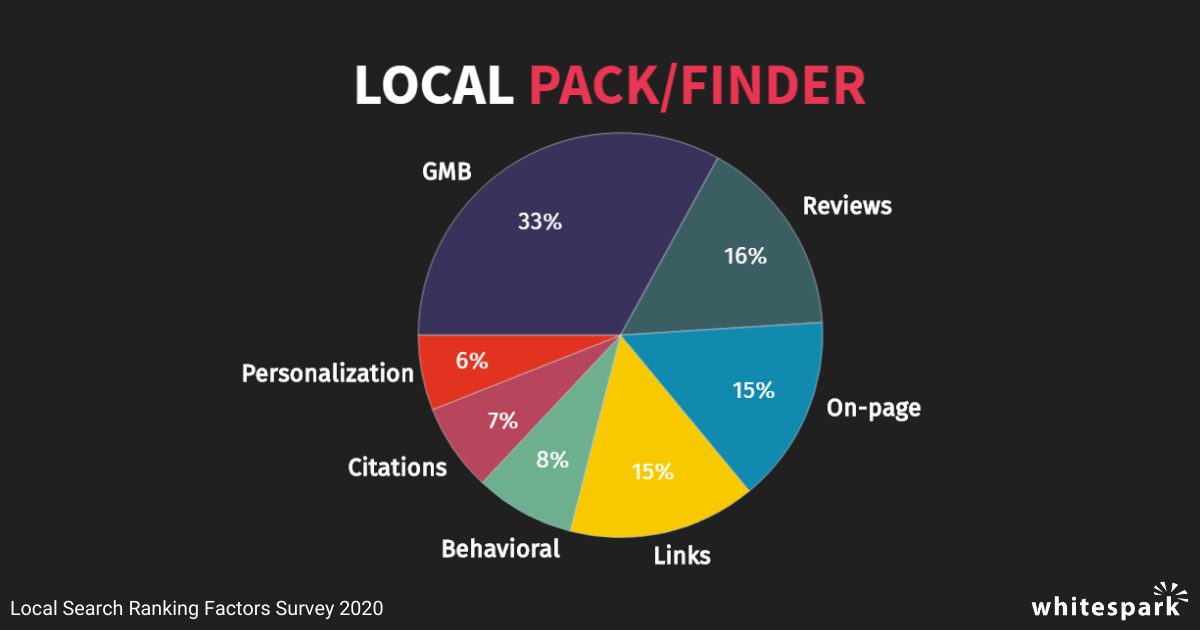
These seven factors should form your audit template. Let’s look at each in greater detail and explore how you can audit them to improve your performance.
1. Google My Business
Start your audit by creating your Google My Business (GMB) account, if you haven’t already. It’s free, and the only prerequisite is that your business should have a physical address. A GMB account will give your business greater credibility and visibility in local Google searches and on Google Maps. This will raise your footfall and sales.
You will also be able to share pictures of your establishment, products, and services. GMB gives you the ability to edit and update your business details, including contact information and hours of service, to ensure customers always have the most up to date information. You can also respond to each online review and promptly address any issues that may arise.
Creating your GMB account is the first step. Your next step is to optimize your GMB for SEO.
The following five steps are essential for optimizing your GMB account.
- Verify your GMB account. Once you have created your GMB account, Google will send you a four-digit PIN by mail and a link, which takes 12-14 days to arrive. Once you receive the pin, go to the link and enter your PIN. Google uses this process to verify the physical location of your business.
- Fill out your profile details. While creating your GMB account, you will notice that some fields are compulsory while others are optional. As far as possible, fill in all the fields. Providing complete information raises the credibility of your business for the search algorithms.
- Ensure name, address, and phone number (NAP) consistency across the web. These details should be the same on all platforms.
- Add pictures. Pictures add to the credibility of your business for search engines and build trust with your customers. Use high-resolution quality photographs of your premises, staff, and products.
- Take advantage of Posts on Google. GMB allows businesses to create interactive posts on events like sales and promotions. Use keywords in these posts to engage and inform your customers. While posts aren’t a ranking factor, they can help drive conversions and clicks.
Not only is GMB a critical factor in local search rankings, but it also offers you a chance to engage with your customers. Before you go any further with your audit, claim your GMB and ensure all your data is accurate.
2. Reviews Signals
Reviews are the second-highest influencer in local search rankings for the simple reason that three out of four consumers place reviews on a par with personal recommendations.
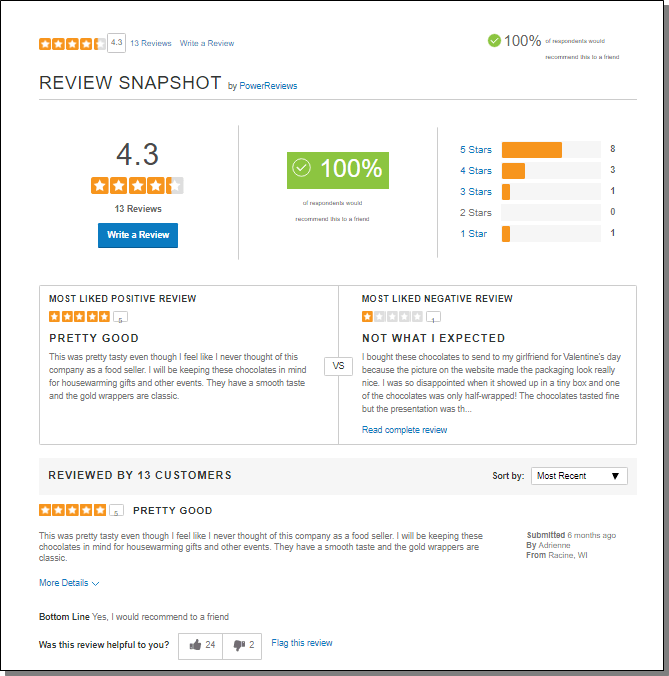
Customers read your business reviews across platforms like Google, social media channels, Yelp, Facebook, and TripAdvisor, and those reviews influence their purchasing decisions. Therefore, you need a process to monitor, scale, and showcase your business’s reviews.
The overall rating of your business is a good indicator of both customer satisfaction and the overall health of your business. Likewise, a spate of negative reviews is an opportunity for some course correction.
How do you scale the number of your reviews? The first and simplest way is to ask your customers to leave a review when they visit your store or buy from you online.
The search algorithms on Google and other search engines are getting smarter by the day, and any attempt to game your reviews will harm your rankings. A little investment in review management will allow you to generate positive reviews and promote them on the appropriate channels by automating your review flows. This will build the credibility of your business and improve your rankings.
3. On-Page Signals
On-page signals consist of the content that you include on your website. Your content is relevant for both traditional and local SEO. On-page SEO will always be an important part of search rankings since Google is trying to identify if your website offers Expertise, Authoritativeness, and Trustworthiness (E-A-T) on your specialization.
At a local level, your content will also indicate if your website is relevant to the searcher’s query. Therefore you will need to either upskill on SEO techniques or have a professional handle this aspect of your business.
The use of keywords is important in your headings, meta descriptions, page URLs, and the content on each page can impact click-through rates and/or rankings. Center your keyword strategy around the search terms that your customers actually use. You can use a keyword tool to help identify keywords relevant to your business.
For better local search rankings, ensure that at least 3-4 pages on your website mention the name of your city and your address. Focus on creating content that is relevant to your city or local area. Posting long-form articles on your website and eliminating duplicate content are also strong on-page SEO signals. Here’s an example:

This long-form piece on the website of Dishoom, a restaurant with several locations in London, tells an engaging story which leads into an announcement about its new outlet opening in Covent Garden. Organic use of the words “Covent Garden” and “London” help it appear in local searches.
4. Link Signals
If you want your page to rank, acquiring backlinks from quality websites is essential. When another website has a link to your site, they are sending one of those E-A-T signals that Google values. Naturally, that would impact your rankings.
The key elements of your link building strategy include:
- Inbound anchor text (the words that are linked from the other website).
- The domain authority of the linking sites (how trusted they are).
- The number of unique linking domains. (Pure quantity of links does matter).
Acquiring backlinks to your website pages can be a difficult task and not one that you can typically automate, but one that is worth the effort. Getting other websites to link to you takes time and outreach. Links could come from directory and review sites, other local businesses, chambers of commerce, local newspapers, or community websites. You can get creative in trying to earn links from your digital community.
From the standpoint of local organic factors, the quality of the links is most important. The quality of your links depends on the domain authority of the website from where the links originate.
Do a periodic audit of your backlink profile to remove links from websites with low domain authority, as these links will negatively impact your local search rankings. You can use tools like Google Search Console (free) or Ahrefs (paid) to monitor and audit your links.
5. Behavioral Signals
Behavioral signals are all about how people interact with your site and content. Behavioral signals relevant to your local SEO include click-through rates, mobile clicks to call, and check-ins.
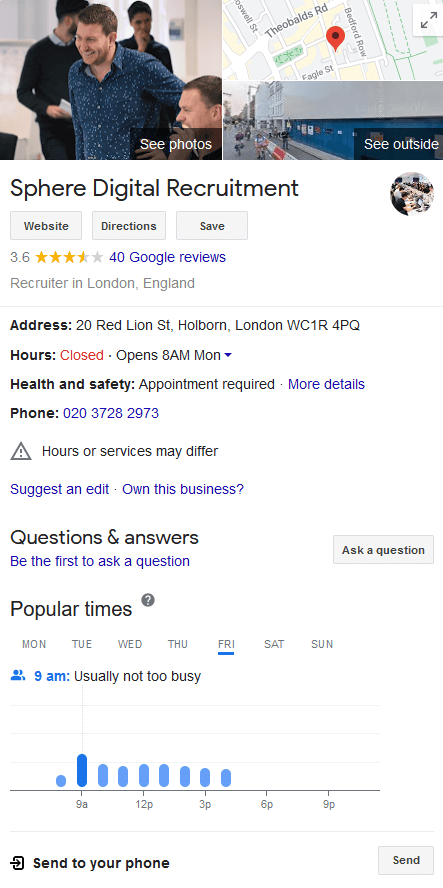
In the above example for a London-based recruitment agency, behavioral signals include leaving reviews, using the “send to your phone” option, and clicking through to the website. These signals are user-generated and less susceptible to manipulation by businesses.
Search engine algorithms use these signals for establishing the credibility of a business. Therefore, these signals should be included in your local SEO audit.
6. Citation Signals
Citation signals that improve your local search rankings include internet yellow pages (IYP), NAP consistency, and citation quantities. NAP is less important than it was a decade ago, but you still want your business details to be accurate everywhere they’re mentioned. Every listing of your business on directories like Yelp, YP.com, Foursquare, and Citysearch is treated as a citation by search engines.
This is because these search engines treat these directories as high-quality citation sites.
These directories are also a quick and easy way to gain backlinks to your website. Listing your business on a high-quality directory can often result in top of the page listings, which is a huge bonus. While you don’t need to be on the 100+ directory sites like you did years ago, being on 20-30 can generate value before you start to see diminishing returns. Take the time to audit your listings to ensure they are up to date and accurate.
Though it’s not something you can easily control, we should also acknowledge the role that personalization can play. Google sometimes personalizes searches based on context such as other recent searches. This isn’t something you can deliberately optimize for but it’s worth bearing in mind.
7. Bonus: Social Media and Competition Audit
Select the social platforms you’ll use for your business based on the demographics of your audience.
A law firm would likely prioritize listing on LinkedIn above Instagram. A family restaurant, on the other hand, would leverage listings on sites like Facebook and Instagram. If you’re using Twitter, you might actually see your tweets in branded search results.
Verify that your business information, logo, and NAP (where mentioned) are consistent across all social channels.
Does each profile include engaging content and a link back to your website?
Check out the listings of your competitors to see if they are using any features that you aren’t, such as Instagram Stories or boosted Facebook posts. You can also evaluate your competitors’ advertising strategies and hooks that they are using and draw inspiration for your channels.
Ensure that you’re publishing great social media content to help drive traffic to your website. Remember that Google Posts require a different strategy than Facebook.
Wrapping up
Congratulations! By working through the 7 factors above, you have completed your local SEO audit. The process will help with your local rankings and give you an insight into how local SEO works and how you can improve your performance.
Audits are not a one-time event. They need to be conducted on an ongoing basis. I recommend doing a full audit about once per year. Documenting the findings of your audit will help you in planning and executing your SEO strategy going forward. It will also help you in identifying the areas where additional efforts are required, areas that can then be evaluated in the next audit.

